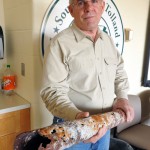
Building and Grounds Supervisor Eric Morgan with a corroded piece of pipe that illustrates maintenance challenges facing the Southwick school system. (Photo by chief photographer Fred Gore)
SOUTHWICK – One of the questions asked by opponents of the proposed school project is “where has the money gone?”
Some residents are concerned about the $72 million cost of the campus-wide project that includes major renovations and/or additions to Woodland Elementary School, Powder Mill Middle School and Southwick-Tolland Regional High School. Opponents of the project have said the school department should have taken care of the issues over the years through the budget and capital expenditures.
Superintendent John Barry, Business Manager Stephen Presnal, former business manager Paul Pettit and Building and Grounds Supervisor Eric Morgan met with The Westfield News this week to talk about the money that has been spent on maintenance and capital projects over the past five years.
“We’ve got a pretty consistent pattern of expenses,” said Barry.
Proof of that is in the facilities operational budgets from 2007- 2011. At Woodland, total operating expenses – excluding salaries – for a five-year period is $805,978. Powder Mill’s five-year total is $1,961,797, and the high schools’ five-year total is $985,558. Broken down over the five years, each year’s total is very similar.
The school department provided detailed information on line items for each school, as well as general maintenance and repairs. In 2007, for example, $19,976 was spent on plumbing and steam traps, with $5,583 spent in the same line item in 2009. Electrical expenses were $32,963 in 2007, and were $14,730 in 2011.
Line items include kitchen equipment maintenance, energy management systems maintenance, fertilizer, sweeping, water and more.
Capital spending has also been steady for the past five years, with the school department requesting $600,000 in borrowing at the annual spring town meeting each year. Barry said transportation and technology comprise the majority of capital spending in recent years.
The school district provides student transportation and owns and maintains its own fleet of buses and vans.
“We have invested about $100,000 in technology,” said Barry. “In 2007, we spent $110,000 on technology, $128,000 for buses, we bought a van, floor tile, gym doors, sidewalks and security.”
Barry said to meet the criteria for capital funding, an item must exceed $5,000 and last more than five years.
Morgan said recent expenditures include $800,000 for replacement of the old electrical heating system at the high school, boiler replacement at Powder Mill, and locker replacement at the high school and middle school.
Last year, $136,709 was spent on buses, $8,000 was spent on musical equipment, $18,100 was spent on a lawn mower, nearly $20,000 was spent on digital projectors and smartboards for all three schools, and $95,000 was spent on upgrading the Local Area Network servers and workstations, among other things.
In 2007, capital expenditures included $95,000 for buses, $12,000 was spent on caulking windows in three schools, $40,000 for replacement of eight sets of interior doors at the high school, and $5,000 was spent on playground improvements.
“I believe we have spent wisely on maintenance and capital borrowing on things we can’t afford,” said Barry.
Morgan displayed a corroded pipe which he said was buried in concrete four feet under Powder Mill and wrapped in asbestos. He said that is just one example of the things that cannot be handled within a school budget or small annual capital fund.
Morgan supervises 11 full-time, and three part-time custodians, charged with building maintenance. One of the custodians is also a licensed plumber, saving the school system additional money.
“That pipe represents the things we cannot maintain,” said Barry, adding that the cost to replace Woodland’s roof is $2.5 million.
“This is not about repairs, this is about systems replacement,” Barry continued. “The scale of it is such that we cannot do it any other way,” he said of the school project.
Barry said the school project began as a way to address overcrowding at Woodland.
“Because of regionalization (with Granville) we got the opportunity to do all this systems work,” said Barry.
Pettit and Morgan said when they started working for the department in 1989, it was a mess.
Pettit, who has the most experience with the schools operating budget, said that tens of millions have been invested in the aging buildings since 1989, and any savings achieved has been rolled over, year to year.
“When I came in, in 1989, these schools had been run into the ground with deferred maintenance,” he said.
Barry said when he initially met with the Massachusetts School Building Authority, members were impressed with what the department had done to keep up with systems and equipment in recent years.
“One of the things the school building authority told us is we’ve kept good care of the physical plant,” said Barry.
The problem, Barry stressed, is that whole systems need to be replaced, single-pane, inefficient windows need to be replaced, roofs need to be replaced, and more.
The school project, which was defeated in Southwick at a ballot vote in late January, addresses the replacements.
Barry said that capital money was used to conduct a feasibility study, putting aside capital purchases for that purpose for the last two years, until it was clear what would be reimbursed by the state, vs. being fully funded by Southwick taxpayers.
Last week, Barry said during a School Committee meeting, that he hoped to have an announcement in the coming week about how the department and MSBA can move forward.

